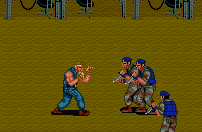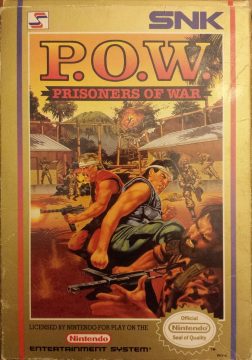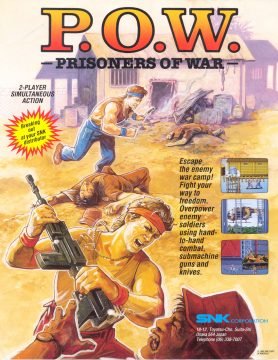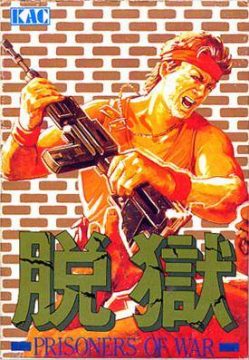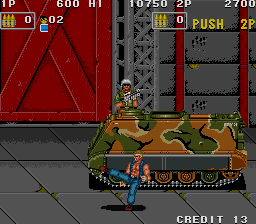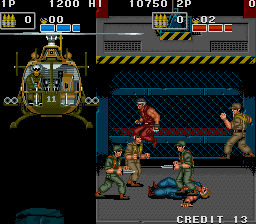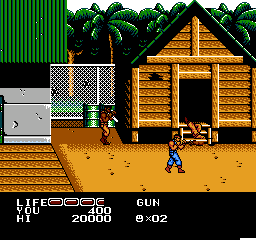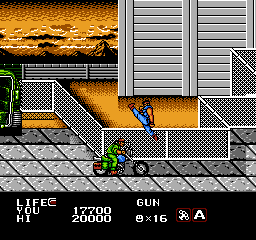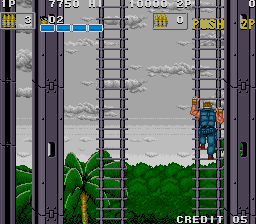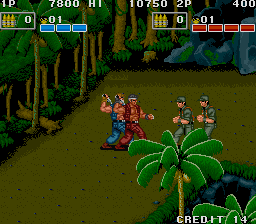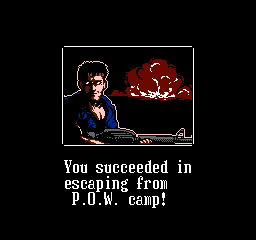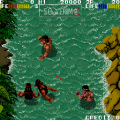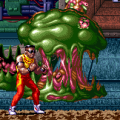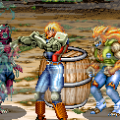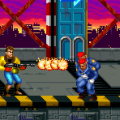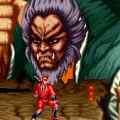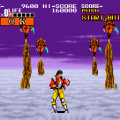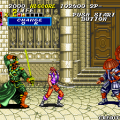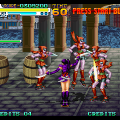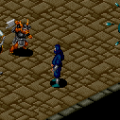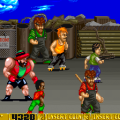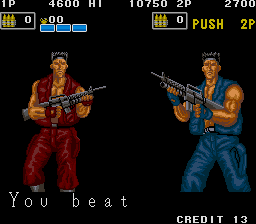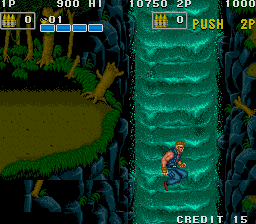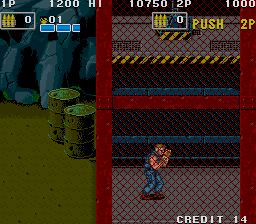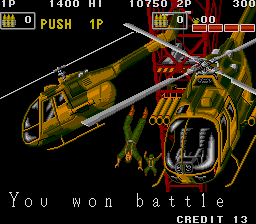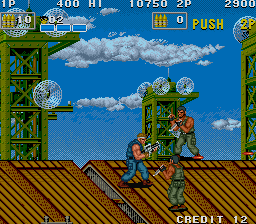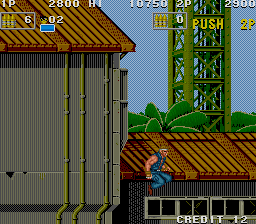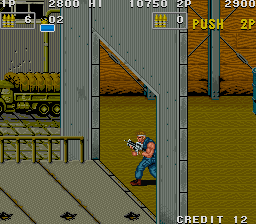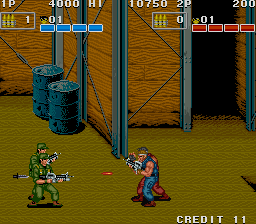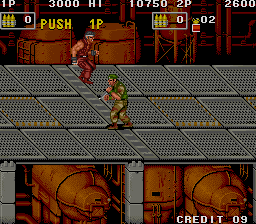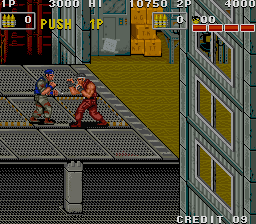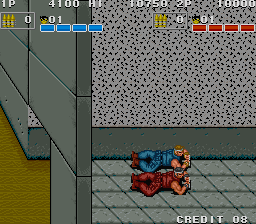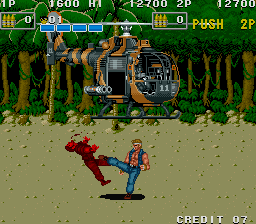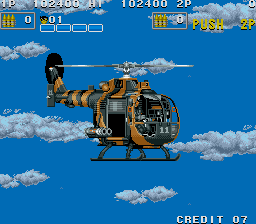While they first started releasing games in 1978 with Ozma Wars, SNK quickly made a name for itself with the popular and groundbreaking 1981 shooter Vanguard. While its soundtrack is notoriously stolen from Star Trek: The Motion Picture and Flash Gordon, it along with other early shooters like Scramble set the stage for the genre we know today. With P.O.W.: Prisoners of War, SNK cashed in on the massive number of action movies focused on rescuing POWs from Vietnam that themselves were all only made to cash in on the success of Rambo: First Blood Part II and Missing in Action. Like in Konami’s Metal Gear series, SNK even has a protagonist named Snake in homage to Escape from New York that would appear in some of their other military themed games as well. We see SNK’s Iron Snake first mentioned in the game TNK III, released in 1985. While the character was fluid enough to be used in both an overhead tank game and a beat-em-up, Iron Snake never developed a solid following like Konami’s character and was quickly forgotten in the face of SNK’s more popular games.
Either way, P.O.W. itself proved to be popular in the arcades and is generally remembered fondly despite its high difficulty and ruthless enemies. While its characters lack the personality seen in games like Final Fight and the variety of bright graphics and attacks in Technos beat-em-ups, it still stands out as a unique take on the genre. It’s also the first beat-em-up to make liberal use of firearms throughout the game. Players can also wield knives picked up from fallen enemies. Like Double Dragon, the game uses three buttons, punch, jump, and kick respectively. While players can perform a jump kick by hitting said buttons at the same time like in most beat-em-ups, P.O.W. offers two more moves. The first is that players can hit punch and kick at the same time to perform a fast head butt, and the other lets players punch enemies behind them by pressing punch and jump simultaneously. We will see SNK use variations on this in their other beat-em-ups like Robo Army and Mutation Nation. While one can kind of sort of get by without those extra moves in their later games, however, mastering all of them is required in P.O.W. as enemies are almost constantly swarming around you. While the game suffers from the low enemy variety seen in many of SNK’s beat-em-ups, there are only a few enemy sprites in the game, the upside is that they come with a wide variety of moves and behaviors for the time which keeps things intense.
That intensity can make the game difficult to approach at first. Almost right out the gate enemies will be charging out at players to attack. Many don’t stick around, simply running off after they’ve taken some damage or fought with you for a certain amount of time. The game does have players facing up to five enemies at once though. This combined with their speed and ferocity sets it apart from its contemporaries like Double Dragon II: The Revenge and Golden Axe, making for an aggressive game that requires constant focus to play successfully. In this respect it would not be surpassed until the release of Final Fight just over a year later.
The key to P.O.W.‘s success is also unfortunately its greatest barrier to new players, the enemies do not stop. The game lacks techniques common in later beat-em-ups like being able to grapple and throw enemies into each other in Final Fight or the various spinning kick attacks in the Double Dragon series. These moves are vital in those games to give the player some breathing room by knocking multiple enemies away.
The lack of them in P.O.W., however, means that players have to be on the offensive at all times and constantly closing in on the game’s enemies. A few missteps or mistimed attacks can cause the player to be overwhelmed and out of lives very quickly. The upside is that the games presentation and the tightness of its animations are enough to make it rewarding to learn and master. It’s also impressive to see such an early beat-em-up already have a good sensibility of action film logic, with the natural flow of the game’s combat looking great when well played. Several modern beat-em-ups like Bayonetta, Shinobi (2002) and Devil May Cry put an emphasis on stylish action, rewarding efficient play with cool looking combos and animations. While P.O.W. is of course years removed from them and designed on much weaker hardware, it actually offers a similar experience. Very few beat-em-ups offer a situation where the player has to quickly grab a gun off the ground, shoot an oncoming enemy off of his motorcycle, and then quickly jump away as the bike skids along and explodes over the course of three seconds. There are also barrels of fuel scattered throughout each level as well which can be set off by explosions or by machinegun fire.
Those explosions are very smoothly animated for their time, and Snake also animates very nicely. A nice touch is that SNK took the time to animate him and the enemies walking around in different directions instead of only drawing the characters facing left and right like in most beat-em-ups. The only other SNK game where they bothered to do this is Sengoku 2, and it’s a rarity in the genre in general. The background graphics are also very nice for a 1988 game. While the nature of the setting would make for less variety from a weaker developer, SNK works in pretty much everything they can to keep the graphics varied. There are also some nice transitions halfway through each level where Snake climbs or dramatically jumps a massive distance. It’s a nice way to keep a feeling of continuity from area to area despite the brief intermission scenes that play when a level is completed.
The soundtrack helps keep the game going as well. Composed by SNK regulars Yoko Osaka (NAM 1975, Guerilla War) and Toshikazu Tanaka (Metal Slug, Power Instinct), it’s a good one. Evocative of the music from Strike Commando and the other films that inspired the game, it’s also noticeably less scratchy sounding than other SNK games on the same hardware. Though as with many game soundtracks its originality can be called into question, the music played during the game’s boss fight is right out of a James Bond movie, and the NES port of the game would “borrow” some music even more liberally. The game’s credits also list a third composer under the alias “KENNY”, who is most likely Kenichi Kunishima (Silpheed, Alisia Dragoon). However, while Yoko Osaka’s contributions to SNK are more accurately documented in their games, Kenichi has a host of aliases he composes under, making this uncertain.
When these popular arcade games were released on the NES, there would often be some drastic changes to their structure to give it an appeal that could no longer be fulfilled with impressive graphics and sound found in more powerful arcade hardware. Enemies and the player’s capabilities would often be changed too to take into account that the game was now meant to be played repeatedly for some time at home, rather than putting in quarters regularly for a few minutes at the arcades. While some games like Bionic Commando and Strider became completely new games during the transition, P.O.W.: Prisoners of War finds a perfect middle ground between being close to the arcade game’s structure while also adding a nice amount of unique content to it. The basic geography you fight through is the same, but additional areas have been added to the game along with a few new enemies. The most noticeable of these is the boss fights. Except for its last level, the arcade version of P.O.W. only has a series of more difficult enemies at the end of each area. In the NES game, however, Snake (now called Bart in the US NES release) must also directly confront a helicopter and armored personnel carrier that are only background elements in the arcades. These can be damaged both with the machinegun (if players manage to keep one until the end of the level) or by hand grenades that can be picked up from defeated enemies.
There are however a few things noticeably missing from the game as well. The most obvious of these is that the characters only have animations for walking left and right no matter what direction they’re moving in. This is commonplace for beat-em-ups, but the extra animation in P.O.W.’s arcade release is a nice detail that helps it stand out. Next, Snake can no longer head butt enemies, though the enemy behavior has been re-balanced so that this move is not needed. We also see that SNK attempted to create a more lighthearted premise in the US release, though it’s a far cry from Konami’s pun-filled instructions:
Your code name is Bart. You are a captain of the Army Special Forces Unit “M”. Your mission is to infiltrate GOON (Government of Offensive Network), a subversive organization whose aim is to break up the international economy and establish a worldwide smuggling ring. You will accomplish this by purposely being captured and imprisoned in their “escape-proof” armed camp. You’ll have to fight your way out with your bare fists – but is you can break into the ammunition depot, you’ll find grenades, knives, and M-16’s to tip the odds in your favor. Your goal is to find and eliminate the leaders of GOON before they can carry out their diabolical scheme!
Code Name: Bart
Captain, Army Special Forces Unit “M”.
Highly skilled in hand-to-hand combat
and familiar with all types of weapons.
HEIGHT: 6′
WEIGHT: 160 lbs.
A worldwide smuggling ring, were they trying to turn this into a war on drugs game? SNK’s early games generally aren’t sugarcoated, being one of the earliest developers ever to make games set during the Vietnam War and they even made Guerilla War, a game where you explicitly play as Fidel Castro and Che Guevara. Either way, it’s a weird change when the original’s story is simple. Besides the names changing to fictional organizations the only difference is that the mission is to assassinate a Russian military officer instead of four burly guys running a “worldwide smuggling operation” out of a backwater POW camp. Those four new characters are the biggest change to the NES game’s structure. P.O.W.‘s “boss fights” in the arcade version are just a large group of enemies. On the NES, however, players get to fight these four would be crime lords along with the helicopter and armored vehicle that function only as background obstacles in the arcades. The Japanese version similarly superfluous, saying that your mission is to stop the four leaders of GOD (Government of Darkness).
Actually fighting the vehicles is a great addition to the game. Since they can only be damaged with grenades grabbed from defeated enemies or with the machinegun if one manages to keep it to the end of the level, both feel like a big deal compared to the game’s regular proceedings. There are also of course enemies coming out regularly to attack you as you fight them. While P.O.W. on the NES only has two enemies on the screen at a time, they tend to take less hits to defeat than their counterparts in the arcade release, which helps keep the game moving. There are also some more items the player can pick up in extra rooms scattered throughout the game. In the arcades, these were areas enemies would emerge from, but on the NES release players can actually enter them for the chance to get some extra equipment. These include an energy refill, brass knuckles that double the strength of the player’s punches, and most usefully body armor that makes them immune to both knives and gunfire.
The new areas are also very well done. Each is based on the transitions from the arcade game but expanded to actually be a short area to fight through instead of just a few seconds of jumping or climbing to watch. Expanding what was already there instead of making a completely new level or two works out great, keeping the seamless progression of the original’s levels. On top of this it even features a new soundtrack by Toshikazu Tanaka that, while a bit more cheerful than his, Yoko Osaka and KENNY’s original work, still fits the game perfectly and has the same level of energy. It seems like a perfect package, and it almost is, but P.O.W. on the NES does have two flaws. One is that it’s only a one player game. This is an acceptable limitation of the NES, but being able to fight and blast through the game with a friend is sorely missed.
The other comes with the addition of those new boss characters. An attempt to give the game some personality and make it more like other beat-em-ups released since P.O.W. hit the arcades, it completely backfires. Each one is tedious and not particularly interesting, fitting very basic archetypes set by Double Dragon. So instead of a sudden encounter with a swarm of more powerful enemies, you face off against guy with a gun, thin fast guy, and slow huge guy (named Don James, Snivel, and Angel respectively) before facing off against The Leader, who doesn’t even have a name. Amusingly however, each boss has a unique theme song, but some will be a bit familiar to players depending on their musical tastes.
Even with those issues, however, P.O.W. is still a great action game for the NES, the challenge and intensity is still there even if the boss fights come up short. SNK actually did learn their lesson with this, however: When they released Ikari III: The Rescue on the NES just under a year later, human boss fights were removed from the game entirely, with every level concluding with an explosive encounter with a military vehicle like the first level of P.O.W. on the NES. While SNK would go on to make a small handful of beat-em-ups on their much more powerful Neo Geo system, games like P.O.W. and make one wonder what they could have accomplished if they stuck with the genre more instead of publishing one on one fighting games almost exclusively in the mid and late 90s.
Despite SNK bringing their A game for P.O.W.: Prisoners of War, the NES version failed to get the long term cult following of games like the Double Dragon series, though it’s a nice change of pace from other NES beat-em-ups. SNK did, however, give the NES release an unexpected PC port in 2008 via the German game download service Gamesload. The arcade game is more fondly remembered, however, and was rereleased by SNK on the PSP compilation SNK Arcade Classics Volume 0. It was also released as a standalone game on the PlayStation Network in 2011. Well worth playing today for its intense action and at great early example of the beat-em-up genre.
